

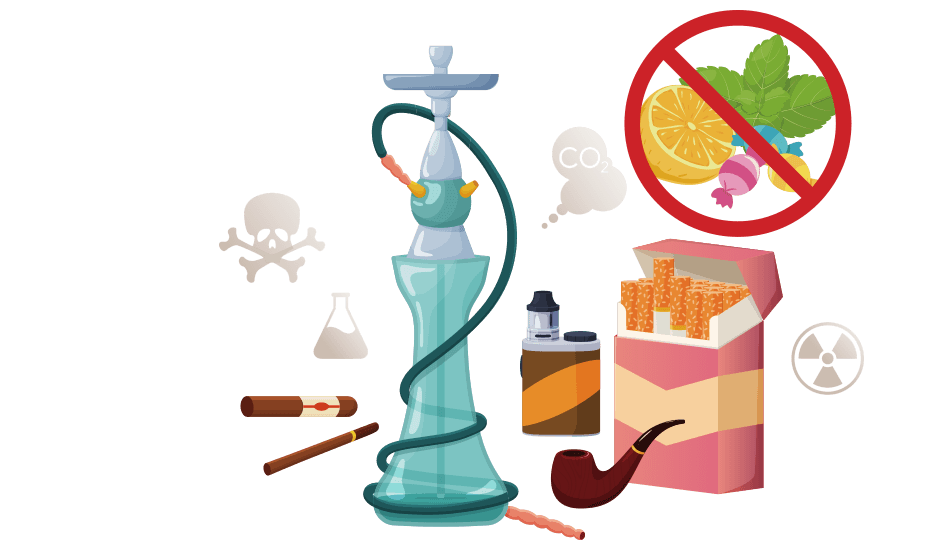
Introduction
Tobacco companies have been adding a great variety of non-tobacco flavours, such as menthol, fruit and confectionery flavours, into tobacco products from time to time to improve the taste and cover the harshness of tobacco smoke and thus making it easier for the development and confirmation of smoking habit by smokers. In recent years, flavour capsules have been added to cigarette filters to enhance smoking experience. These capsules are to be crushed by smokers before or during smoking to release the flavour additives into the smoke. In some products, smokers can even choose multiple capsules for a single cigarette.
Launching new products with various flavours is a key marketing strategy of tobacco companies to sustain the demand, in particular among the youth, for their products. The descriptions that depicts and patterns which causes association with flavours on the packaging can further enhance the attractiveness of the products. Studies show that flavoured products are particularly appealing to young people and women.[1]
The guidelines for implementation of Articles 9 and 10 of the FCTC recommend prohibiting or restricting the use of ingredients that may increase the palatability of tobacco products.[2] The WHO Study Group on Tobacco Product Regulation also recommends a ban on menthol or additives with menthol flavour in tobacco products.[3]
The roles of flavour additives tobacco products in smoking initiation, dependence and cessation are well documented in scientific research. By introducing flavours and reducing harshness of cigarette smoke, flavoured tobacco products would facilitate initiation and maintenance of smoking. They also reduce smokers’ risk perception.
In fact, menthol cigarettes are more addictive than their non-menthol counterparts. Young people who start smoking menthol cigarettes are at a greater risk of progression to established smokers compared to those who start with non-menthol cigarettes.[4] Studies also show that both youth[5] and adult menthol smokers[6] are more dependent on nicotine and have a lower success rate in smoking cessation. They are also more likely to relapse after quitting.[7] Overseas experience shows that since menthol cigarettes would induce smoking initiation, and their use among the youth has remained stable in the past decade despite decrease in non-menthol cigarettes use.[8]
Other than menthol, certain flavourings such as cinnamaldehyde[9] and diacetyl[10] which infuse cinnamon and buttery flavours to cigarettes, are chemicals toxic to the respiratory system.[11][12] These additional flavourings will bring more harm to their users than conventional tobacco products. Studies confirm that banning the sale of menthol cigarettes can apparently help encourage menthol smokers to quit and increase cessation rates.[13][14][15][16] Meanwhile, some additives can improve the taste of tobacco products or make them more palatable, despite having no noticeable flavours.
Experiences outside Hong Kong
By now, over 50 countries have introduced legislations on flavours of tobacco products, including the United States, Canada and Singapore.[17] The ways such legislations are enforced depend on the definition of tobacco products in different countries.
- Has prohibited sale of flavoured tobacco products (except those with menthol flavour) since 2009
- Announced the prohibition of sale of all flavoured tobacco products through legislation in 2022
- Prohibits sale of menthol-flavoured tobacco products
- Prohibits sale of flavoured cigarettes, cigars and rolling papers
- Prohibits sale of waterpipe tobacco with fruit flavours
Prohibiting flavor descriptors and the display of wording or graphics triggering associations of added flavours on tobacco packaging is an important measure to prevent tobacco companies from circumventing the flavour ban. Regions banning both flavoured tobacco products and the display of flavour descriptors on product packaging include the European Union (EU)[18] and Canada.[19] Mandating the adoption of plain packaging for tobacco products through legislation is a highly effective way to outlaw the display of flavour descriptors on product packaging.
Moreover, EU[20], United Kingdom[21], Canada[22] and some other overseas regions have prohibited the addition of ingredients to tobacco products that will make the products seem healthier (such as vitamins) or more energetic (such as caffeine), produce colours or more palatable.
Local situation
Although the smoking prevalence in Hong Kong is gradually decreasing, the sales volume of cigarettes with flavour capsule has increased instead. It is estimated that 13% of all cigarettes sold in 2020 contain flavour capsules. The sales volume for such kind of cigarettes is expected to increase to 17% by 2025.[23] The sales proportion of menthol-flavoured cigarettes and cigarettes with flavour capsule increased from about 30% in 2015 to 41% in 2020, indicating that young adults are having a growing preference to menthol or other flavoured cigarettes.
According to a survey conducted by the School of Public Health of the University of Hong Kong in 2021, the prevalence of ever smoking among Secondary 1 to 6 students was 7.4% (i.e. over 24,000 secondary school students), reflecting that there are still a significant number of students who will experiment with smoking out of curiosity. We also notice an increase in the market launches of tobacco products (including cigarettes and waterpipe tobacco) with various flavours such as menthol and fruit that are designed to increase palatability and appeal to teenagers. Apart from influence of other people, other reasons commonly cited by daily smokers for initiating smoking include “looking stylish” and “attracted by the tobacco flavour”.[24] Hence, we have to reduce the attractiveness of tobacco products and take more effective measures to preclude young people from accessing such products.
At present, over one-third of smokers in Hong Kong consume flavoured cigarettes regularly. [25]
Chart 4.1: Flavour of tobacco products consumed by daily smokers
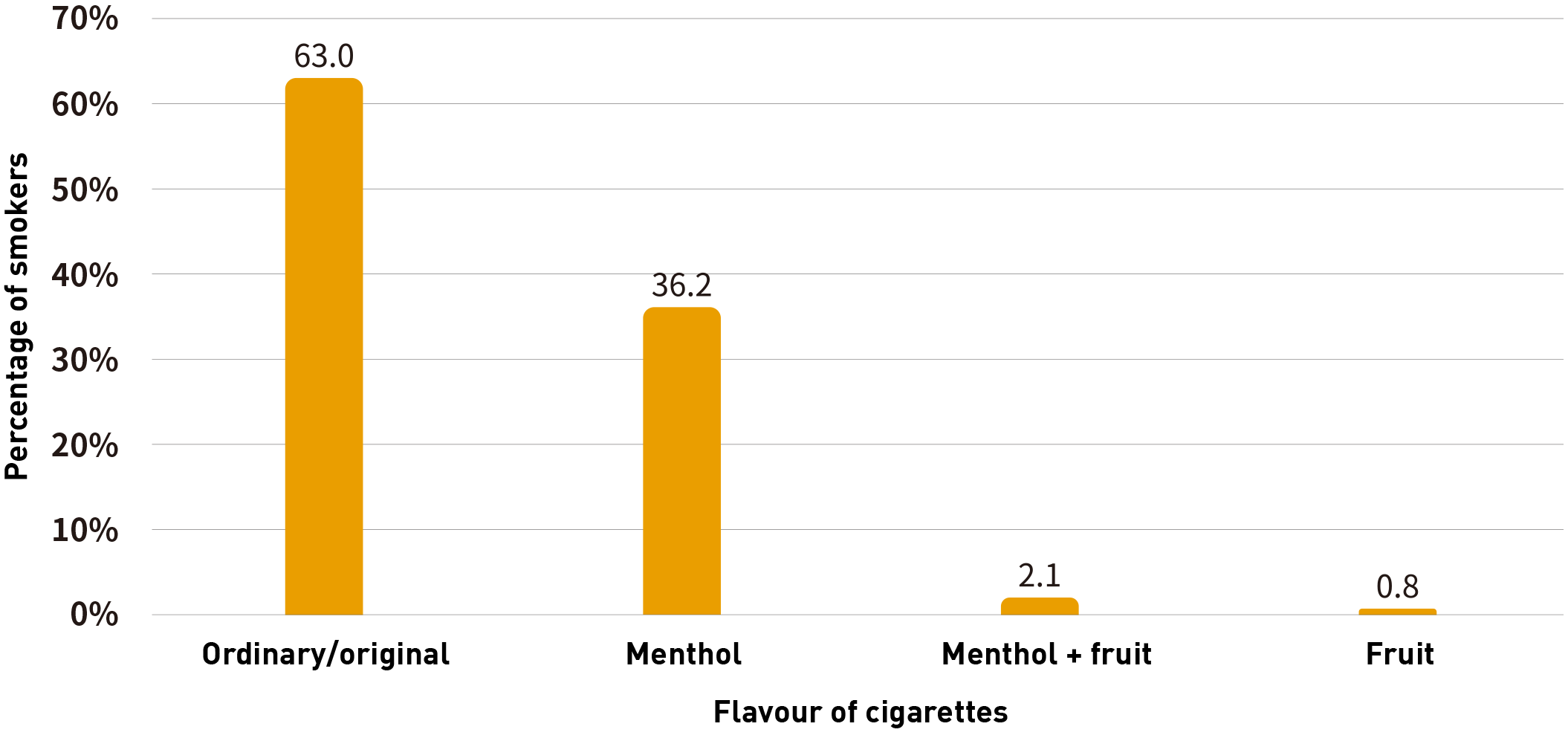
About 50% of the smokers aged 20-39 consumed menthol-flavoured cigarettes in their first attempt of smoking.
Chart 4.2: Flavour of tobacco products consumed by daily smokers in their first attempt of smoking by age group
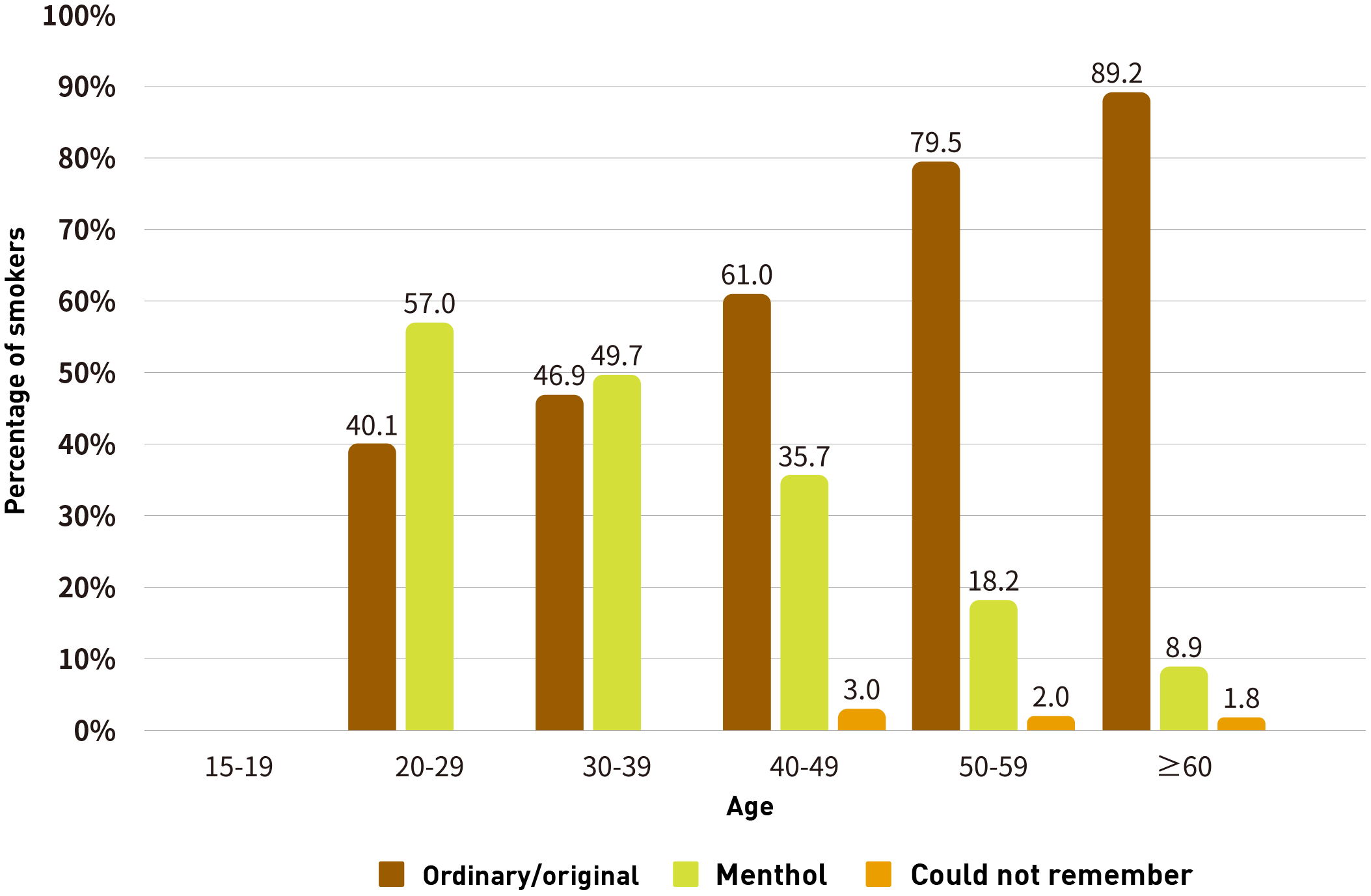
Statistics show that the majority of young and female current smokers choose tobacco products with menthol or other flavours.[26] Over 90% of smokers who initiated smoking with menthol-flavoured cigarettes will continue to consume the same type of products. Local data also shows that the market share of flavoured tobacco products has been on an increasing trend.
Chart 4.3: Flavour of tobacco products consumed by daily smokers by age group
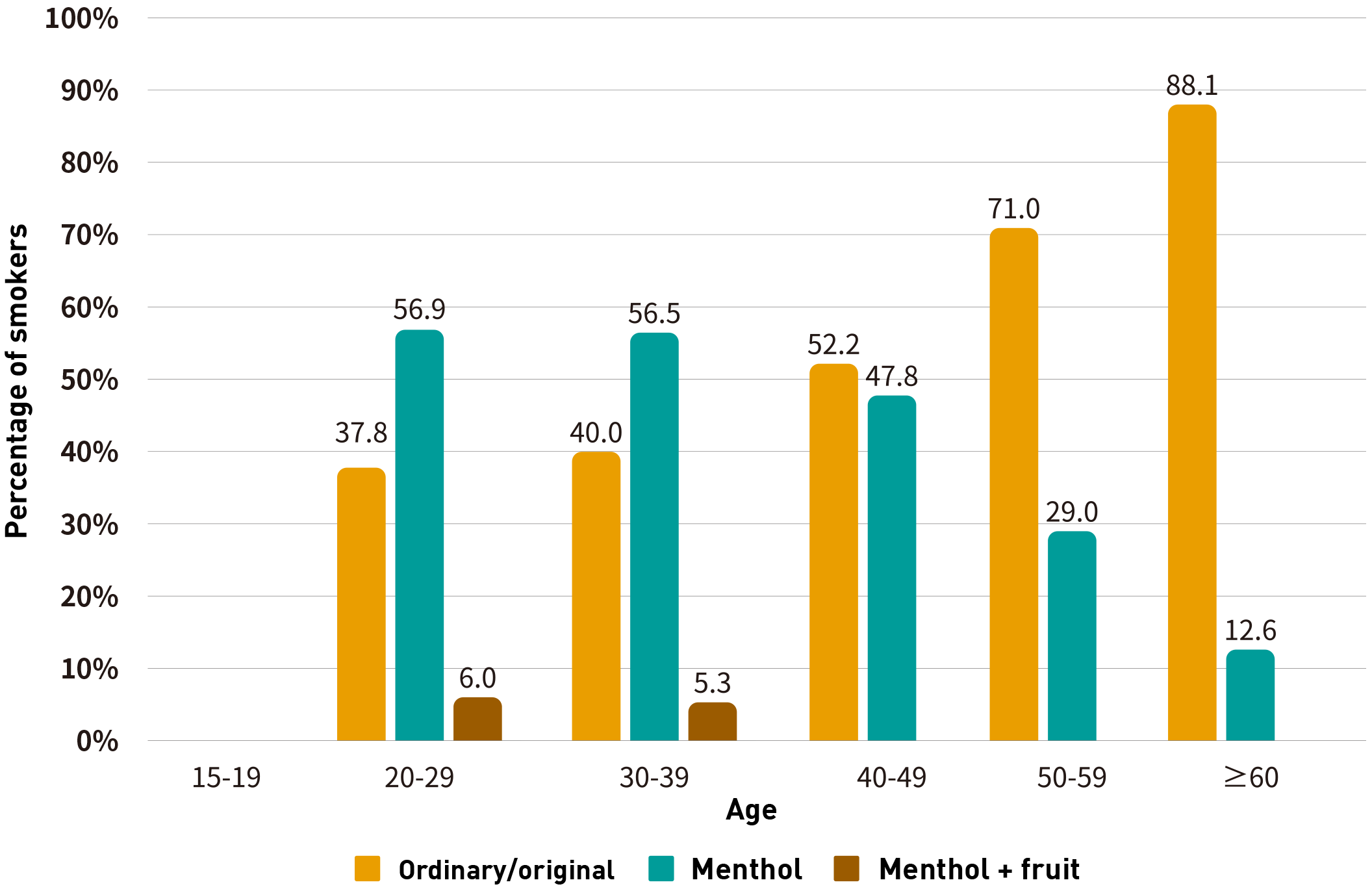
Chart 4.4: Flavour of tobacco products consumed by daily smokers by gender
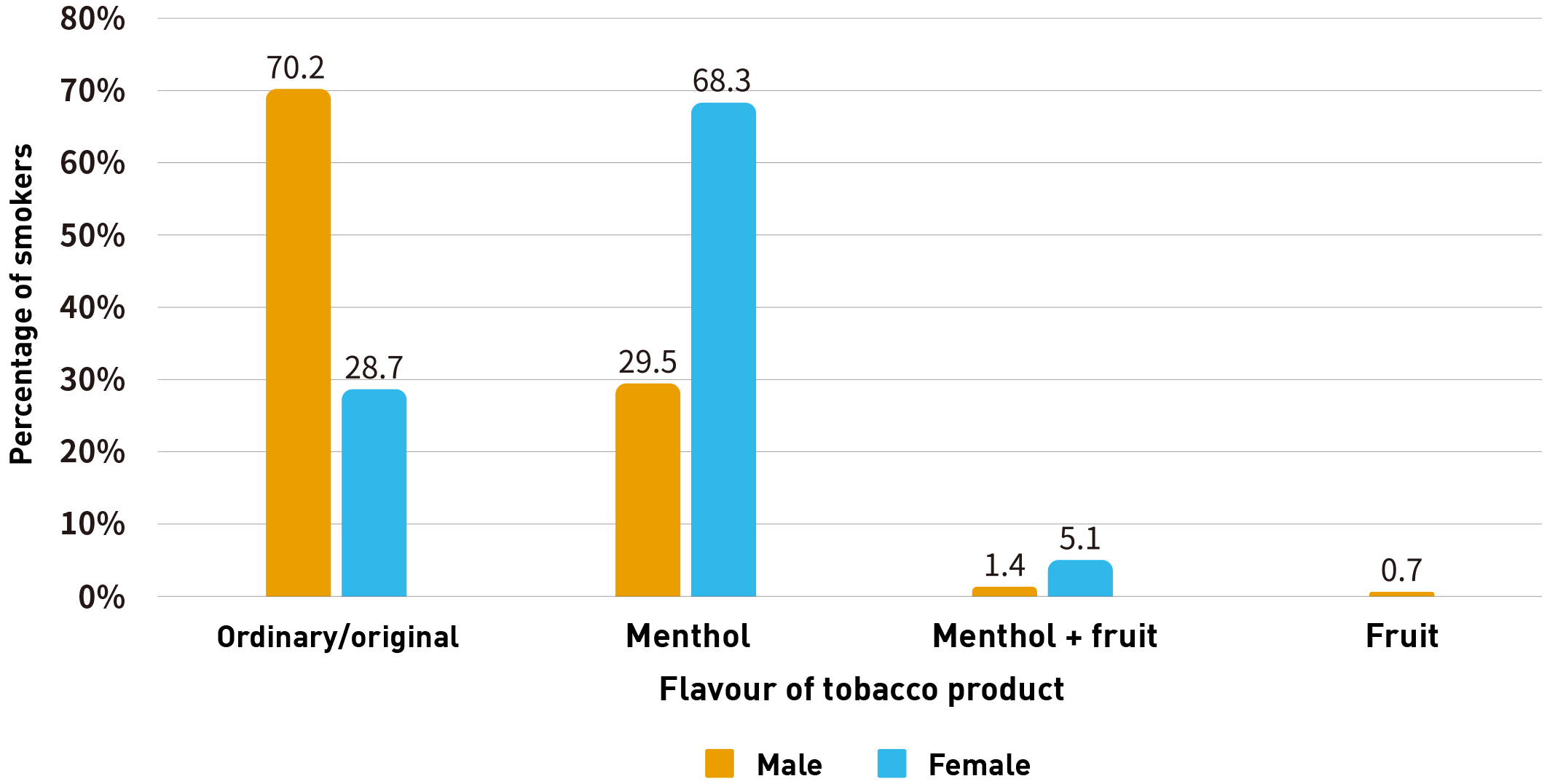


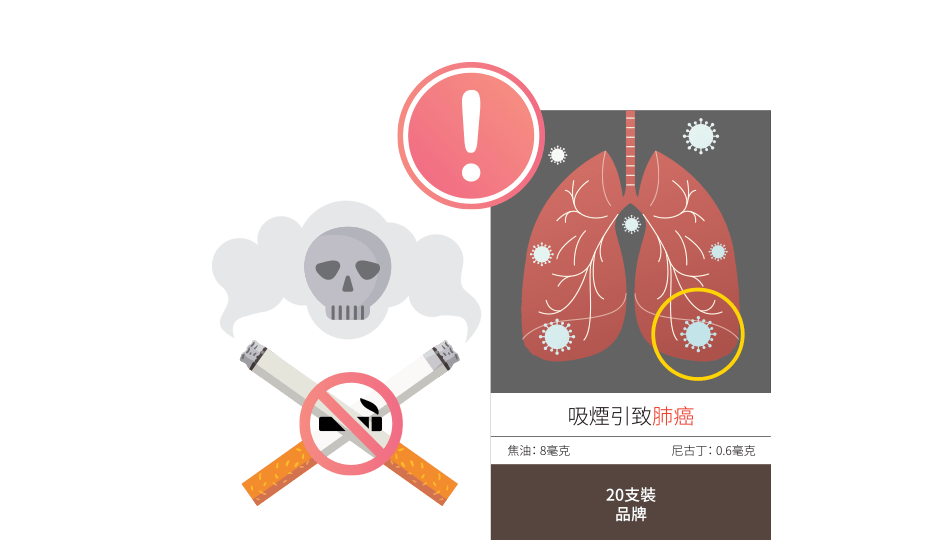
Introduction
WHO defines “plain packaging” as the measure to restrict or prohibit the use of logos, colours, brand images or promotional information on packaging other than brand names and product names displayed in a standard colour and font style.[27]
For products of relatively homogenous design like cigarettes, packaging is the predominant tool used by tobacco companies for consumers to differentiate between brands. The Government has restricted the advertising and promotion of tobacco products in phases over the years, banning tobacco advertisements on TV, radio, printed media and the internet. Promotion of the sale of tobacco products through offering gifts or raffles was also prohibited. After rounds of amendments made to the Smoking (Public Health) Ordinance, various types of direct advertising and promotion of tobacco products can hardly be seen in local media. Nonetheless, tobacco companies can still make use of the packaging design and display of tobacco products at retail points to promote their products. Evidence shows that the packaging and display of tobacco products are important means of marketing. The pattern, wording and colours of tobacco packaging can manipulate consumers’ risk perception and directly influence their purchase decisions.[28],[29] Cigarette packs are mobile advertisements with high visibility and exposure since they are carried around by smokers.[30] Cigarette packaging influences the appeal of the products to teenagers and young people – the critical period when the vast majority of smokers started smoking.[31]
Therefore, plain packaging serves the following purposes –
- Eliminating the advertising and promotional functions of tobacco packaging;[32][33]
- Eliminating the adverse effect of packaging design on reducing smokers’ risk perception; and
- Increasing the noticeability and effectiveness of health warnings on tobacco packaging.[34][35][36]
Figure 4.1: Plain packaging guidelines in United Kingdom[37]
![Figure 4.1: Plain packaging guidelines in United Kingdom[37]](../project/hb/upload/image/2023/06/00470/423aa447cf0602ed94d950b1498b9058.png)
The FCTC obliges Parties to adopt and implement effective packaging and labelling measures as part of the comprehensive tobacco control initiatives. The guidelines for implementation of Article 11 of the FCTC states that Parties should consider adopting measures to restrict or prohibit the use of logos, colours, brand images or promotional information on the packaging other than brand names and product names displayed in a standard colour and font style (i.e. plain packaging). The guidelines for implementation of Article 13 of the FCTC also states that “packaging and product design are important elements of advertising and promotion. Parties should consider imposing the requirement of plain packaging to eliminate the effects of advertising or promotion on packaging.”
In general, plain packaging adopts relatively plain colours to tie in with the standard fonts to reduce the differences between brands. Health warnings will also take up a larger proportion of area on the packaging. Depending on the tax regime of individual regions, a specific fiscal marking would be attached to some tobacco packaging for easy identification.
Overseas experience
Different regions have adopted plain packaging for tobacco products –
- Requires all cigarette packaging be printed in specific colours and fonts
- Cigarette packaging must contain health warnings and quitline information
- Requires all cigarette, cigar and cigarillo packaging be printed in specific colours and fonts
- Cigarette packaging must contain health warnings and quitline information
- Packaging of all tobacco products must carry health warnings
- Starting from 1 August 2023, health warnings such as “Cigarettes cause cancer” or “Cigarettes cause leukaemia” should be printed on each cigarette stick, to ensure the health warnings can be spotted by the smokers
Australia was the first country to introduce plain packaging in 2012. Studies show that after the introduction of plain packaging, the smoking prevalence was reduced by 0.55% in 3 years (from December 2012 to September 2015).[38] Compared to the period before the implementation of plain packaging, smokers in Australia were 1.4 times more likely to show intention to quit, and were 1.5 times more likely to make a quit attempt after the measure was implemented.[39] Studies also show that smokers became more aware of the harmfulness of cigarettes in the first year when the measure was implemented in Australia, and that the percentage of smokers believing that brands do not differ in harmfulness increased from 65.7% to 69.8% one year after the measure was implemented.[40] WHO pointed out in a report in 2016 that there were substantial research data supporting plain packaging could help reduce the attractiveness of tobacco products.[41]
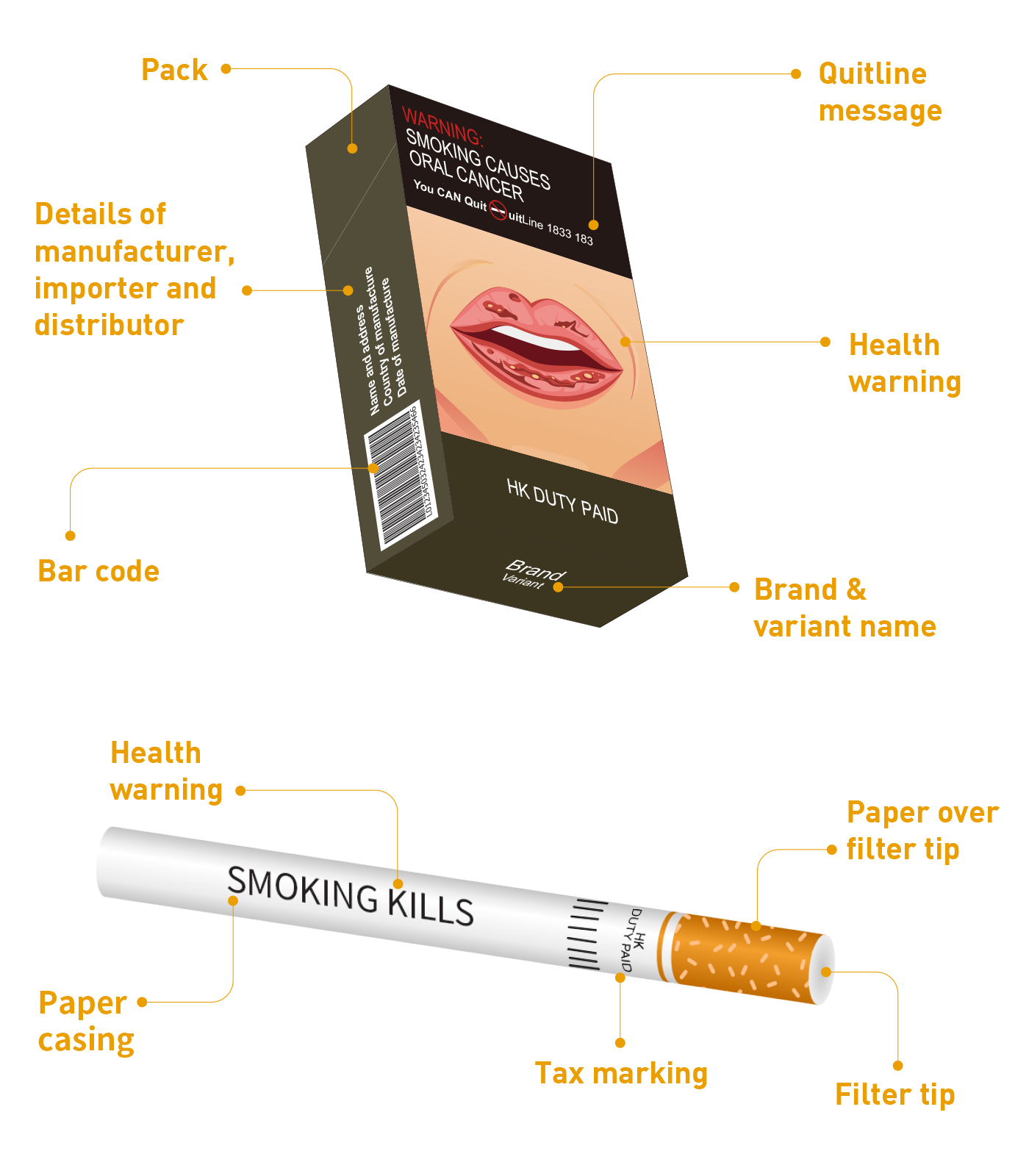
Local situation
Although the existing legislation requires that the packet and retail container must bear a health warning, the tar and nicotine yields in the prescribed form and manner, there is currently no standardised packaging for tobacco products in Hong Kong.


All tobacco products sold in Hong Kong are required to bear health warnings on the two largest surfaces of the packets and retail containers, and the health warnings must cover at least 85% of the display area. Although the law prohibits the use of descriptors on tobacco packaging “which may create an erroneous impression that the products are less harmful to health than other conventional smoking products without such descriptors on the packaging”, there is no express provision that prohibits or regulates the use of other forms of descriptors.


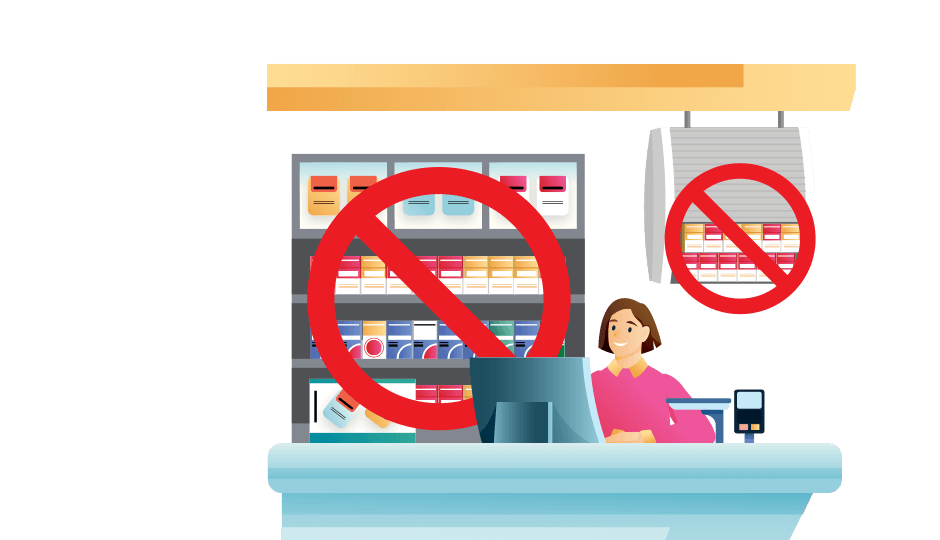
Introduction
The Government started its regulation on tobacco advertisements since 1982. Currently, tobacco products can hardly be advertised through mass media. Display of tobacco products at retail outlets remains one of the very few ways for the tobacco industry to advertise its products by making use of cigarette packs. Studies show that display of tobacco products at retail outlets can encourage impulsive consumption by smokers,[42] induce non-smokers to smoke[43] and tempt smokers who are trying to quit or recently quitted from relapsing again.[44]
The guidelines for implementation of Article 13 of the FCTC states clearly that the display of tobacco products at retail outlets constitutes advertising and promotion. WHO opines that display of tobacco products is a key means of promoting tobacco products and tobacco use, including stimulating impulse purchases of tobacco products, giving people the impression that tobacco use is socially acceptable and making it harder for smokers to quit. Young people are particularly vulnerable to the promotional effects of product display.[45]
Evidence has shown that banning display at retail outlets is an effective tobacco control measure. A global study of 77 countries reveals that banning the display of tobacco products at retail outlets is effective in lowering smoking prevalence with the smoking prevalence of daily adult smokers, males and females reduced by about 7%, 6% and 9% respectively.[46]
With reference to Article 15 of the FCTC, WHO recommends that the Parties should implement further measures, including establishing a licensing system or regulating the production and distribution of tobacco products in order to prevent illicit tobacco trade. In the long term, increasing the cost of non-compliance by retailers can ensure that the regulations on tobacco products are strictly complied with, which can help reduce exposure of tobacco products in public.
Experiences outside Hong Kong
Multiple regions have regulated the sale and display of tobacco products at retail points, including Australia, Finland, New Zealand, Singapore, Thailand and United Kingdom.[47]
- From July 2023 (exact time to be confirmed), retailers can apply for becoming authorised retailers of tobacco products
- If retailers want to continue selling tobacco products after 30 June 2024, they must apply for becoming authorised retailers of tobacco products from 1 October 2023
- Tobacco products cannot be displayed or made visible to the public
- Storage units should be self-closing, opaque and placed in a fixed location at the retail outlets or in an area not accessible and visible to the public
- Each retail outlet should apply for an individual licence
- Licensees are subject to background check
- Prohibit any access to tobacco products except by staff of the retail outlet; the outlet should keep the record of each transaction for at least a year for checking by enforcement agents
- Offenders are subject to fines or revocation of their tobacco retail licences
- Tobacco products cannot be displayed or made visible to the public
- Offenders are subject to a fine of GBP5,000 and imprisonment for 2 years
Local situation
Under the prevailing legislation, retailers are allowed to display tobacco products for sale at retail outlets, but they have to place a sign in English and Chinese indicating that no tobacco product shall be sold to any person under the age of 18 or given to any person for promotional or publicity purposes at a prominent position at their premises. The design, size and number of price marker of tobacco products displayed at retail outlets should meet specific requirements.
In recent years, there has been an increase in display of tobacco products at retail outlets. We notice that tobacco companies and retail outlets have exploited grey areas of the law to conduct advertising activities for tobacco products. At some retail outlets, tobacco products are placed in specially designed display boxes or on back-lit panels to echo and highlight the packaging design of the products being promoted. As TACO has stepped up enforcement against advertising activities of tobacco products, the number of summonses issued for such activities reached a record high of 85 in 2021. As the display boxes and back-lit panels are inexpensive to produce and install, and the penalty for illegal tobacco advertisements is generally light, yet the prosecution process is usually lengthy involving huge administrative work, the enforcement action which requires substantial resources has limited deterrent effect. In view of the above, it is necessary to have a total ban on display of tobacco products at retail outlets and increase the penalty for illegal tobacco advertising to prevent tobacco companies from continuing to exploit the grey area for tobacco advertising activities.
Chart 4.5:Enforcement on Tobacco Advertisements
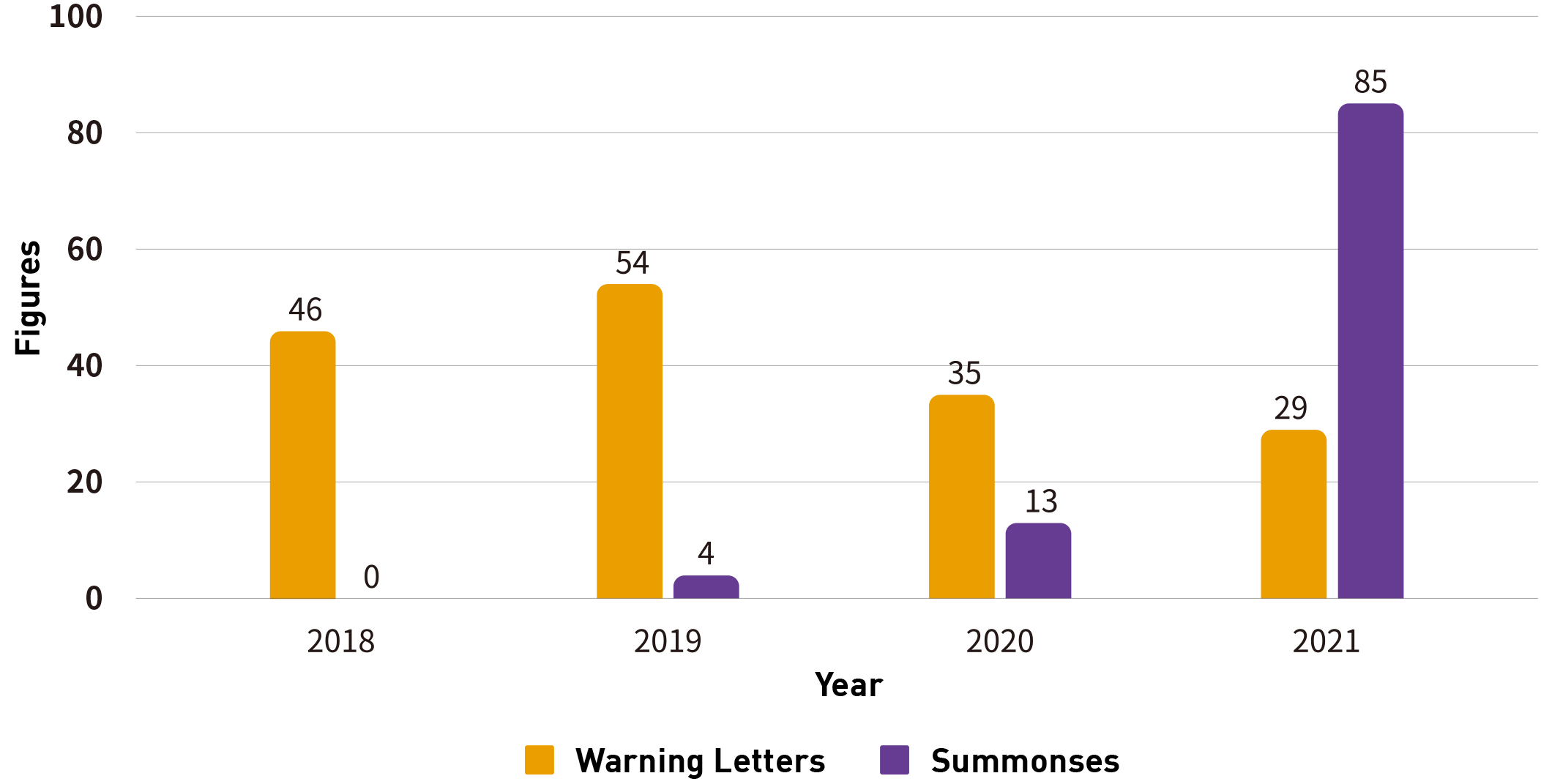
In regard to the retail of tobacco products, according to the Smoking (Public Health) Ordinance, no person shall sell any cigarettes to persons under 18, that are not pre-packaged, and retail container must bear a health warning, the tar and nicotine yields in the prescribed form and manner in the cigarette pack. Sale of tobacco products from a vending machine is also prohibited in Hong Kong. Any person who contravenes the above regulations is liable on summary conviction to a fine of $50,000.
- Patten T, De Biasi M. History repeats itself: Role of characterizing flavors on nicotine use and abuse. Neuropharmacology. 2020 Oct 15;177:108162.
- World Health Organizatio Partial guidelines for implementation of Articles 9 and 10. 2017
- World Health Organizatio Advisory note: banning menthol in tobacco products: WHO study Group on Tobacco Product Regulation (TobReg). 2018.
- Nonnemaker J, et al. Initiation with menthol cigarettes and youth smoking uptake. Addictio 2013;108(1):171–8.
- Hersey JC, et al. Menthol cigarettes contribute to the appeal and addiction potential of smoking for youth. Nicotine Tob Res. 2010;12(Suppl 2):S136–46.
- Rosenbloom J, et al. A cross-sectional study on tobacco use and dependence among women: does menthol matter? Tob Induc Dis. 2012;10(1):19.
- Levy DT, et al. Quit attempts and quit rates among menthol and nonmenthol smokers in the United States. Am J Public Health. 2011;101(7): 1241–7.
- Giovino GA, et al. Differential trends in cigarette smoking in the USA: is menthol slowing progress? Tob Control. 2015;24(1):28–37.
- Lerner CA, et al. Vapors produced by electronic cigarettes and e-juices with flavorings induce toxicity, oxidative stress, and inflammatory response in lung epithelial cells and in mouse lung. PloS One. 2015;10(2):e0116732.
- Klager S, et al. Flavoring chemicals and aldehydes in e-cigarette emissions. Environ Sci Technol. 2017;51(18):10806–13.
- Lerner CA, et al. Vapors produced by electronic cigarettes and e-juices with flavorings induce toxicity, oxidative stress, and inflammatory response in lung epithelial cells and in mouse lung. PloS One. 2015;10(2):e0116732.
- Klager S, et al. Flavoring chemicals and aldehydes in e-cigarette emissions. Environ Sci Technol. 2017;51(18):10806–13.
- Chung-Hall J, Fong GT, Meng G, Cummings KM, Hyland A, O'Connor RJ, Quah AC, Craig LV. Evaluating the impact of menthol cigarette bans on cessation and smoking behaviours in Canada: longitudinal findings from the Canadian arm of the 2016–2018 ITC Four Country Smoking and Vaping Surveys. Tobacco control. 2022 Jul 1;31(4):556-63.
- Fong GT, Chung-Hall J, Meng G, Craig LV, Thompson ME, Quah AC, Cummings KM, Hyland A, O'Connor RJ, Levy DT, Delnevo CD. Impact of Canada’s menthol cigarette ban on quitting among menthol smokers: pooled analysis of pre–post evaluation from the ITC Project and the Ontario Menthol Ban Study and projections of impact in the USA. Tobacco Control. 2022 Apr 28.
- Fong GT, Chung-Hall J, Meng G, Craig LV, Thompson ME, Quah AC, Cummings KM, Hyland A, O'Connor RJ, Levy DT, Delnevo CD. Impact of Canada’s menthol cigarette ban on quitting among menthol smokers: pooled analysis of pre–post evaluation from the ITC Project and the Ontario Menthol Ban Study and projections of impact in the USA. Tobacco Control. 2022 Apr 28.
- East KA, Reid JL, Burkhalter R, Kock L, Hyland A, Fong GT, Hammond D. Evaluating the outcomes of the menthol cigarette ban in England by comparing menthol cigarette smoking among youth in England, Canada, and the US, 2018-2020. JAMA Network Ope 2022 May 2;5(5):e2210029-.
- Erinoso O, Smith KC, Iacobelli M, Saraf S, Welding K, Cohen JE. Global review of tobacco product flavour policies. Tob Control. 2021 Jul 1;30(4):373-9.
- European Commissio Tobacco Products Directive. 2016. https://health.ec.europa.eu/tobacco/product-regulation/implementing-tobacco-products-directive-directive-201440eu/revision-tobacco-products-directive_en
- Government of Canada. Justice Law Website. https://laws-lois.justice.gc.ca/eng/acts/t-11.5/page-6.html. Updated December 2022.
- European Commissio Tobacco Products Directive. 2016. https://health.ec.europa.eu/tobacco/product-regulation/implementing-tobacco-products-directive-directive-201440eu/revision-tobacco-products-directive_en
- The Tobacco and Related Products Regulations 2016.
- Tobacco and Vaping Product Act.
- Euromonitor International. Tobacco in Hong Kong, China. 2021.
- Census and Statistics Department. Thematic Household Survey Report No.75. 2022.
- Census and Statistics Department. Thematic Household Survey Report No.75. 2022.
- Census and Statistics Department. Thematic Household Survey Report No.75. 2022.
- World Health Organizatio Plain packaging of tobacco products: evidence, design and implementatio 2016. https://www.who.int/publications/i/item/9789241565226.
- Wakefield M, Morley C, Horan JK, et al. The cigarette pack as image: new evidence from tobacco industry documents. Tob Control 2002;11:i73-i80
- Hammond D. Standardized packaging of tobacco products: Evidence review. Prepared on behalf of the Irish Department of Health; March 2014.
- Wakefield M, Morley C, Horan JK, et al. The cigarette pack as image: new evidence from tobacco industry documents. Tob Control 2002;11:i73-i80.
- Hammond D. Standardized packaging of tobacco products: Evidence review. Prepared on behalf of the Irish Department of Health; March 2014.
- Zacher M, Bayly M, Brennan E, Dono J, Miller C, Durkin S et al. Personal pack display and active smoking at outdoor café strips: assessing the impact of plain packaging 1 year post implementatio Tob Control 2015; 24:ii94 - ii97.
- World Health Organizatio Plain packaging of tobacco products: evidence, design and implementatio 2016. https://www.who.int/publications/i/item/9789241565226
- Germain D, Wakefield M, Durkin S. Adolescents’ perceptions of cigarette brand image: does plain packaging make a difference? Journal of Adolescent Health 2010; 46:385–392.
- Al-Hamdani M. The effect of cigarette plain packaging on individuals’ health warning recall. Healthcare Policy 2013; 8(3):68-77.
- Yong H, Borland R, Hammond D, et al. Smokers’ reactions to the new larger health warning labels on plain cigarette packs in Australia: findings from the ITC Australia project. Tob Control 2016;25:181-187.
- https://www.gov.uk/government/publications/health-matters-tobacco-standard-packs/health-matters-tobacco-standard-packs
- Chipty T. Study of the Impact of the Tobacco Plain Packaging Measure on Smoking Prevalence in Australia. Australian Government Department of Health. 2016. https://www.health.gov.au/sites/default/files/study-of-the-impact-of-the-tobacco-plain-packaging-measure-on-smoking-prevalence-in-australia.pdf.
- Durkin S, et al. Short-term changes in quitting-related cognitions and behaviours after the implementation of plain packaging with larger health warnings : findings from a national cohort study with Australian adult smokers. Tobacco Control 2015;24:ii26-ii32
- Wakefield M, et al. Australian adult smokers’ responses to plain packaging with larger graphic health warnings 1 year after implementation: results from a national cross-sectional tracking survey. Tob Control 2015; 24:ii17
- World Health Organizatio Plain packaging of tobacco products: evidence, design and implementatio 2016. https://www.who.int/publications/i/item/9789241565226
- Carter OB, Mills BW, Donovan RJ. The effect of retail cigarette pack displays on unplanned purchases: results from immediate post purchase interviews. Tob Control 2009;18(3):218–21.
- Robertson L, Cameron C, McGee R, Marsh L, Hoek J. Point-of-sale tobacco promotion and youth smoking: a meta-analysis. Tob Control. 2016;25(e2):e83–9.
- Robertson L, McGee R, Marsh L, Hoek J. A systematic review on the impact of point-of-sale tobacco promotion on smoking. Nicotine Tob Res. 2015 Jan;17(1):2-17.
- World Health Organizatio WHO Framework Convention on Tobacco Control Guidelines for implementation of Article 13. 2013.
- He Y, Shang C, Huang J, et al. Global evidence on the effect of point-of-sale display bans on smoking prevalence. Tobacco Control 2018;27:e98-e104.
- Areas outside Hong Kong do not include Mainland China
- Smokefree Action Coalitio Point of Sale Display. 2013. https://smokefreeactioorg.uk/smokefree/point-of-sale-display/



